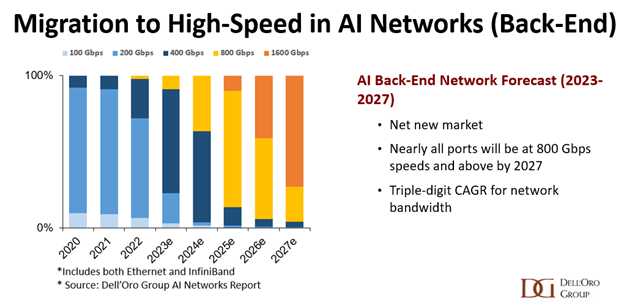2024 is sure to bring new challenges, as well as many exciting opportunities. Check out a roundup of some networking insights from industry experts, analysts, journalists, vendors and telecom executives, exploring the networking trends taking hold in 2024.

The Network is the Computer for AI Workloads
“By 2027, we anticipate that nearly all ports in the AI back-end network will operate at a minimum speed of 800 Gbps, with 1600 Gbps comprising half of the ports.”
Virtualization in the network
“The goal of virtualization is to create something that looks like a traditional resource but is really a service. Virtualization is a form of abstraction; you represent all those routers and trunks with a service that looks like routers and trunks but is managed by the provider. You represent a data center network as a real LAN, but it’s actually an overlay on a LAN – an overlay you can change and move without impacting gear. It disconnects users and applications from reality, in a sense, and gives more control to the things and people who use the network than to the technology of the network. That’s pulling the traditional network apart as each mission pulls virtualization in its own direction.”
A surge in AI Enterprise workloads
“We expect a surge in AI Enterprise workloads with the need for Networking and Edge seamless infrastructure integration. (eg AI/Edge as a service, Network AI, AI for Network, Network APIs for monetization of AI and Intelligence eg CAMARA).”
Telecoms operators will accelerate AI adoption
“AI technology in general (and GenAI in particular) is reaching the maturity to support widespread task automation. It offers a significant opportunity to enhance capabilities but reduce headcount, with consequent rapid growth in CSPs’ profitability. The significant reduction in headcount requirements will be seen first in sales teams (linked to the move to digital channels), moving to software development and network operation functions over the longer term.”
New Application Architectures Will Demand New Kinds of Infrastructure
“I&O teams are continually challenged to meet new and growing demands with new types of infrastructure — including edge infrastructure for data-intensive use cases, non-x86 architectures for specialized workloads, serverless edge architectures, and 5G mobile service. Gartner predicts 15% of on-premises production workloads will run in containers by 2026, up from less than 5% in 2022.
I&O professionals must evaluate alternative options with care, focusing on their ability to manage, integrate and transform in the face of constraints on time, talent and resources. “Don’t revert to traditional methods or solutions just because they’ve worked well in the past,” said Delory. “Challenging periods are times to innovate and find new solutions to meet business demands.”
Edge & Cloud Convergence
“In practical application, edge computing takes the forefront to enhance the performance of existing applications like video streaming and online gaming. Simultaneously, cloud computing assumes a pivotal role in the rapid deployment of new applications and services, ensuring cost-effectiveness. The synergy between edge and cloud computing extends its reach to enable novel use cases, including industrial automation, while employing cloud computing to execute AI and ML models, automating processes at the edge.”
AI Reshapes Data Centers
“Omdia has seen all major enterprise verticals take a substantial interest in cloud services, and we believe the enterprise interest will extend into the AI realm to aid their business model evolution. Google Cloud has coined the term ‘ultrascale infrastructure’ to describe their vision of next-generation infrastructure required. Omdia has begun tracking the trigger points that will signal the transition to an ultrascale DCI [data center interconnect] environment.”
Ian Redpath, Research Director, Transport Networks and Components, Omdia
How do You Think 2024 will Impact Networking?
2024 promises to be another interesting year for networking. Network operators can look forward to modernizing their networks, and planning for new services. To reap the benefits of Artificial intelligence (AI) and machine learning (ML)technologies will require tremendous capacity and inter- and intra-data center connectivity. Looking ahead, the networking industry will have a chance to implement further advances and innovations that promise new possibilities for network operators and the connectivity experience.
With SPs advancing on their migration cloud-based operations, they will need to focus on modernizing mission-critical network infrastructure to support growing network demands.
So, expect to see service providers intensify their activities in these areas to weather today’s challenges and emerge fitter on the other side.
White Paper
DriveNets Network Cloud




